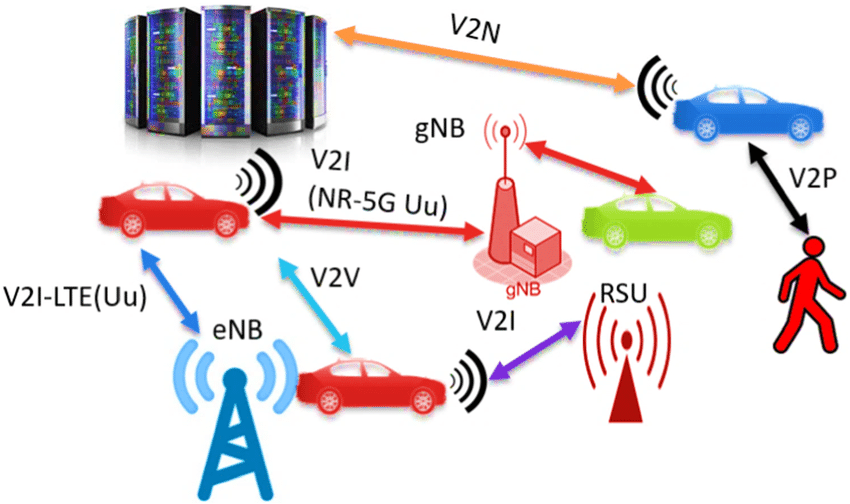V2X Communication in 5G: The Future of Connected Vehicles
telcomatraining.com – The rise of 5G technology is poised to revolutionize various industries, and one of the most promising applications is in the automotive sector. V2X (Vehicle-to-Everything) communication is a critical technology that enables vehicles to communicate with each other and their environment in real-time. With 5G, V2X has the potential to enhance vehicle safety, enable autonomous driving, and optimize traffic management systems. In this article, we explore how V2X communication, powered by 5G, is shaping the future of connected vehicles.
What is V2X Communication?
V2X stands for “Vehicle-to-Everything” communication, a broad term encompassing the ability of a vehicle to communicate not only with other vehicles (V2V) but also with infrastructure, pedestrians, cyclists, and even cloud-based systems (V2I, V2P, V2C). By sharing vital data, such as speed, position, and road conditions, vehicles can make real-time decisions, improving safety and efficiency on the roads.
Traditional automotive communication systems, such as those relying on 4G or Wi-Fi, are limited in terms of speed and latency. However, with the advent of 5G, the potential for V2X communication expands exponentially, creating a new wave of possibilities for connected vehicles.
The Role of 5G in V2X Communication
5G technology brings several key benefits to V2X communication, including ultra-low latency, high bandwidth, and reliable connectivity. These features are crucial for ensuring that data is transmitted in real-time, allowing vehicles to respond quickly to potential hazards and changes in traffic conditions.
- Ultra-Low Latency: One of the most significant advantages of 5G over previous generations is its incredibly low latency—often under 1 millisecond. In the context of V2X communication, this means that vehicles can exchange information almost instantaneously, reducing reaction times in critical situations like collision avoidance or emergency braking.
- High Bandwidth: 5G offers a significantly higher bandwidth compared to 4G, which allows for the transmission of larger amounts of data. This is essential for real-time applications in autonomous vehicles, such as high-definition maps, live sensor feeds, and vehicle diagnostics, all of which require a continuous, high-speed data stream.
- Reliable Connectivity: With 5G’s robust and reliable network architecture, vehicles can stay connected even in congested or remote areas where traditional networks might struggle. This consistency is crucial for maintaining continuous communication between vehicles and infrastructure, enabling smoother and safer driving experiences.
Key Benefits of V2X Communication in 5G for Connected Vehicles
- Enhanced Safety Features:
By enabling vehicles to “talk” to each other and to surrounding infrastructure, V2X can significantly reduce the likelihood of accidents. For instance, if a vehicle detects a sudden obstacle or an accident ahead, it can instantly send a warning to nearby vehicles, allowing them to adjust their speed or change lanes. - Autonomous Driving Capabilities:
V2X communication will be fundamental in enabling fully autonomous vehicles. With the real-time data provided by V2X, self-driving cars can make decisions based not only on their immediate surroundings but also on information from nearby vehicles, road signs, and traffic lights. This interconnected environment is essential for safe and efficient autonomous driving. - Improved Traffic Management:
V2X can also help optimize traffic flow. By communicating with traffic signals, road sensors, and other infrastructure, vehicles can receive updates on optimal routes, traffic congestion, and potential hazards. This can reduce travel times, decrease fuel consumption, and lower overall emissions, contributing to smarter, more sustainable cities. - Environmental Impact:
As more vehicles adopt V2X-enabled systems, the collective data shared between vehicles can lead to better traffic management and more efficient use of roadways. This reduction in congestion directly translates to lower carbon emissions, aligning with global efforts toward reducing the environmental impact of transportation.
The Future of Connected Vehicles
As 5G technology continues to expand, the integration of V2X communication will be a driving force behind the evolution of connected and autonomous vehicles. The combination of high-speed, low-latency networks and intelligent communication systems will enable safer roads, more efficient travel, and the eventual realization of fully autonomous transportation.
Moreover, as 5G infrastructure continues to be deployed globally, the potential for innovation in smart cities and connected transportation systems will continue to grow, making the future of mobility increasingly interconnected, automated, and sustainable.
Conclusion
V2X communication, powered by 5G, holds tremendous potential for transforming the automotive industry. By enabling vehicles to communicate seamlessly with each other and their environment, 5G will enhance safety, enable autonomous driving, and improve traffic management. As we move towards a future of connected vehicles, the role of V2X communication will be pivotal in shaping the way we travel, making our roads safer, smarter, and more efficient than ever before.







